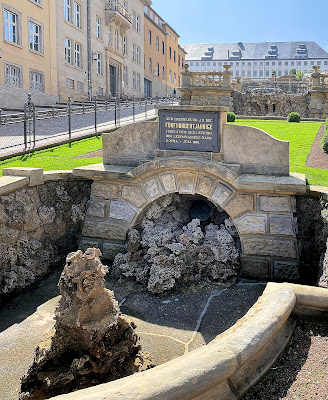Coburg and Gotha are two cities in Germany. The first is located in Franconia, and the second is in Thuringia. Red Baron visited Gotha twice but only passing through, so when I was in Erfurt, the city was just a 20-minute train ride away. I decided to spend one day in Gotha while keeping my residence in Erfurt.
The Dukes of Saxe-Coburg are a branch of the Wettiner, and their history is somewhat complicated. To make a long story short, the first Duke of Saxe-Coburg and Gotha was Ernest I, who reigned from 1826 to 1844.
In the meantime, the marriage policy of the House turned out to be as efficient as that of the Habsburgs. As Wikipedia knows, Ernest's younger brother Léopold became King of the Belgians in 1831, and his descendants continue to serve as Belgian monarchs. Léopold's only daughter, Princess Charlotte of Belgium, was the consort of Maximilian I of Mexico, and she was known as Empress Carlota of Mexico in the 1860s. Ernest I's second son, Prince Albert (1819–1861), married Queen Victoria in 1840 and is the progenitor of the United Kingdom's royal family.
The actual founder of the British line Saxe-Coburg and Gotha is King Edward VII (1901–1910), the eldest son of Albert and Victoria. In 1917, Edward's son, George V (1910–1936), renamed the royal line the House of Windsor while Britain was fighting Germany in the First World War.

|
| The streetcar took me from the station (lower right) to the Bertha-von-Suttner-Platz (upper right) from where I followed the red line to the Hauptmarkt (primary market). |

|
| Gotha's Townhall and the Castle uphill |
Walking up to Gotha Castle, I saw two city archaeologists at work.
Further uphill, I passed the Gothaer Wasserkunst, an artificial brooklet without water due to repairs.
When I looked back at the Hauptmarkt, I noted the red tower of Gotha's town hall. The house in the sun on the right is the Lucas Cranach Haus, now a museum. Lucas Cranach the Elder (1472-1563) lived most of his life in Wittenberg but owned this house in Gotha.
Further up the hill, I approached the ducal castle from the left side, following the red line on the city plan. Schloss Friedenstein was built from 1643 to 1654; the name was chosen allegorically to honor the end of the Thirty Years' War and the Peace of Westphalia.
The wearing of mouth-nose covers was obligatory in the museum. The statue of the founder in the entrance rotunda, Duke Ernest II, was decorated accordingly.
Above the main entrance, the House of Saxe-Coburg and Gotha coat of arms greets the visitor. Schloss Friedenstein and its exhibitions were still closed to the public, so I walked through the gate hall and entered the vast courtyard.
I noticed how impressive the building was when I looked back into the courtyard.
I followed the red line on the plan, walked over the hill, and descended to the ducal museum, which was built from 1864 to 1879.
Ernst II was the only German prince who took the March Revolution of 1848 seriously. In 1849, he decreed Saxe-Coburg and Gotha the most progressive constitution in the German territories.
The quality of the paintings was not up to the impressive building, although
some original works of Lucas Cranach the Elder should be mentioned.

|
| Abraham van Dyck (1635-1672): Old Woman with Book. Van Dyck was a Rembrandt pupil. |

|
| From the workshop of Lucas Cranach, the Elder: Portraits of Martin Luther and his wife, Katharina von Bora |
 |
| Damnation and Salvation by Lucas Cranach, the Elder |
The explanation reads as follows: The painting illustrates Luther's teaching on the justification of every person alone before God. The tree of life and death divides the image into two halves: on the left, the sinful person who has acted against the law is driven into hell by death and the devil. On the right, the guilt-laden person, accompanied by John the Baptist, is discovering the grace of God through Christ's suffering and death.
I walked through the ducal park to the station and took a train back to Erfurt in the early afternoon.
*









No comments:
Post a Comment